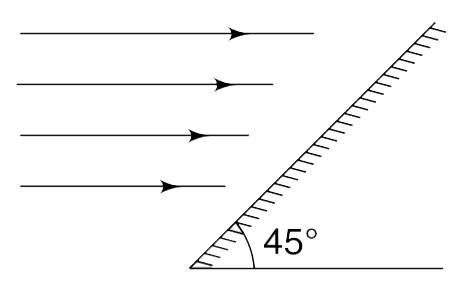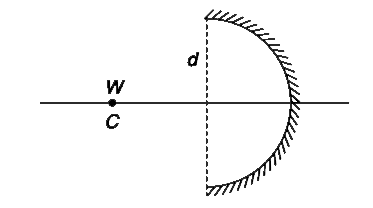All Questions from ARIHANT PHYSICS Chapter 11 WAVE PARTICLE DUALITY AND ATOMIC PHYSICS for Class 12
| Class 12 | PHYSICS |
| Chapter | WAVE PARTICLE DUALITY AND ATOMIC PHYSICS |
| ARIHANT PHYSICS | All Questions |
| Medium | English |
| Academic Year | 2023-2024 |
Question 1
The brightness of an incandescent light bulb is con- trolled by a regulator. The regulator is a variable resistor connected in series with the bulb. What happens to the colour of the light given off by the bulb as the resistance of the regulator is increased? What happens to the average energy of photons given out by the bulb? Does it increase? View SolutionQuestion 3
A 0.6×10−3W laser is aimed at the Moon. The wavelength of emitted light is 600 nm and the laser beam spreads out of the source at a divergence angle of θ=0.5×10−3rad. The Earth-Moon distance is nearly 4×108m. Calculate the maximum number of photons arriving per second per square meter on the Moon? Neglect any absorption by the atmosphere. View SolutionQuestion 5
When photons of wavelength λ1=2920Å strike the surface of metal A, the ejected photoelectron have maximum kinetic energy of k1eV and the smallest de-Broglie wavelength of λ. When photons of wavelength λ2=2640Å strike the surface of metal B the ejected photoelectrons have kinetic energy ranging from zero to k2=(k1–1.5)eV. The smallest de-Broglie wavelength of electrons emitted from metal B is 2λ. Find
(a) Work functions of metal A and B.
(b) k1
Take hc=12410eVÅ View SolutionQuestion 6
Work function of metal X is equal to 3.5eV and work function of material Y is equal to ionization energy of He+ ion in its first excited state. Light of same wavelength is incident on both X and Y. The maximum kinetic energy of photoelectrons emitted from X is twice that of photoelec- trons emitted from Y. Find the wavelength of incident light. hc=12400eVÅ. View SolutionQuestion 7
A particle of mass m is allowed to fall freely under gravity on an elastic horizontal surface. The quantum effect become important if the smallest de-Broglie wavelength of the particle is of the same order as the height from which it was dropped. Write the mechanical energy of the particle if quantum effects become importantView SolutionQuestion 12
In a nuclear physics experiment, electrons are to be accelerated so as to have de-Broglie wavelength of the order of the diameter of a heavy nucleus (~10–14m). Determine the momentum of the electron needed to make the wavelength of electrons equal to diameter. Use the classical formula for momentum, p=m0v to determine the speed of electrons. Is this speed permissible? Now use the relativistic mass of the electrons in the expression of momentum to find the speed of electrons. Relativistic mass is given by m=m0√1−v2/c2.
Where m0 is rest mass and v is speed of the particle.View SolutionQuestion 13
A parallel beam of monochromatic light of frequency v is incident on a surface. Intensity of the beam is I and area of the surface is A. Find the force exerted by the light beam on the surface for following cases–
(i) the surface is perfectly absorbing and the light beam is incident normally on it.
(ii) the surface is perfectly reflecting and the light beam is incident normally.
(iii) the surface is perfectly absorbing and the light beam is incident at an angle of incidence θ.
(iv) the surface is perfectly reflecting and the light beam is incident at an angle of incidence θ. View SolutionQuestion 15
Intensity of sunlight on the surface of the earth is I=1400W/m2 (neglecting atmospheric absorption).
(a) Find the Wattage of the Sun.
(b) Assuming that light emitted from the sun is monochromatic having wavelength l=6000Å, estimate the number of photons emitted from the sun in one second.
(c) According to mass energy equivalence principle, estimate the decrease in mass of the sun in one second.
Given: h=6.64×10−34Js,c=3×108m/sView SolutionQuestion 16
A perfectly absorbing solid sphere with a known fixed density, hovers stationary above the sun. This is because the gravitational attraction of the sun is balanced by the pressure due to the sun’s light. Assume the sun is far enough away so that it closely approximates a point source of light. Find the radius of the sphere and prove that it is independent of the distance of the sphere from the Sun.View SolutionQuestion 19
A gas of hydrogen - like atoms can absorb radiations of 698eV. Consequently , the atoms emit radiation of only three different wavelengths . All the wavelengthsare equal to or smaller than that of the absorbed photon.
a Determine the initial state of the gas atoms.
b Identify the gas atoms
c Find the minimum wavelength of the emitted radiation ,
d Find the ionization energy and the respective wavelength for the gas atoms.View SolutionQuestion 23
A hydrogen like atom (atomic number = Z) is in higher excited state of quantum number n. This excited atom can make a transition to first excited state by successively emitting two photons of energy 22.94eV and 5.15eV. The atom from the same state n can make transition to second excited state by successively emitting two photons of energies 2.4eV and 8.7eV. Find values of n and Z. View SolutionQuestion 24
A system of positron (+1e0) and electron (–1e0) is called Positronium atom. The radii of Positronium atom is expanded but energy levels are reduced by a factor of x compared to H – atom.
(a) Find x
(b) Is it true to say that the entire spectrum of Positronium will be shifted towards longer wavelength compared to H – atom.View SolutionQuestion 25
A negatively charged muon (mass 207 times the mass of an electron) is captured in a Bohr’s orbit of high principal quantum number (n). The atom thus formed is called mesic atom. The muon in high energy state cascades down to lower orbits by emitting photons.
(a) The emitted photons are X rays. Why?
(b) Find the atomic number (Z) of a mu-mesic atom in which the orbit with n=1 will just touch the nuclear surface. Assume that the nucleus has equal number of protons and neutrons.View SolutionQuestion 27
Hydrogen atoms in ground state are bombarded by electrons accelerated through a potential difference of V volts. For what range of values of V, will we get only one spectral line in the spectrum of hydrogen atoms excited by impacts of electrons? Take ground state energy of hydrogen atom to be –13.6eV.View SolutionQuestion 29
An electron in an excited hydrogen atom makes transition from a state of quantum number n to a state of quantum number (n–1).
(a) Show that the frequency of emitted radiation is intermediate between the frequencies of orbital revolution in initial and final states.
(b) What is the relationship between frequency of emitted photon and the orbital frequency of the electron when n is large? View SolutionQuestion 31
A tube contains a sample of hydrogen atoms which are all in their third excited state. The atoms de-excite and a spectrum of the radiation emitted is obtained. The spectrum is shown in the given figure.

(a) Which of the lines (1,2,3,4,5 or 6) represent a transition from quantum state n=3 to n=2.
(b) Which of the lines represent the one with second smallest wavelength? View SolutionQuestion 34
Radiation from hydrogen gas excited to first excited state is used for illuminating certain photoelectric plate . When the radiation from same unknown hydrogen-like gas excited to the same level is used to expose the same plate , it is found that the de Broglie wavelength of the fastest photoelectron has decreased 2.3timegt It is given that the energy corresponding to the longest wavelength of the Lyman series of the known gas is 3 times the ionization energy of the hydrogen gas (13.6eV). Find the work function of photoelectric plate in eV. [Take(2.3)2=5.25] View SolutionQuestion 36
X-ray spectrum obtained from a metallic target has been shown in the figure. The spectrum has been obtained for four different accelerating voltages in the X-ray tube: 25kV, 20kV, 15kV and 10kV.
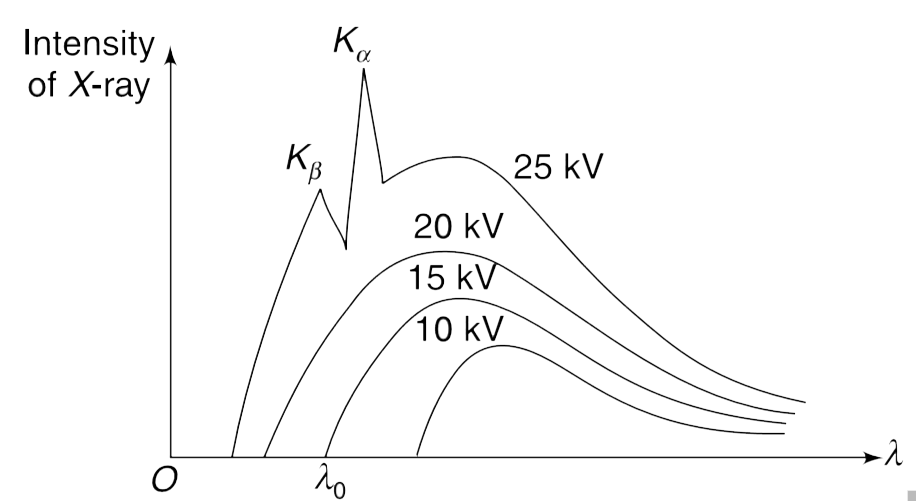
(a) Find the value of λ0 shown in the graph.
(b) What can you say about the energy of a K-shell electron in the target atom? View SolutionQuestion 37
When the voltage applied to an X-ray tube increases from 10 to 20kV the wavelength difference between the ka line and the short wave cut-off of continuous X-ray spectrum increases by a factor of 3.0. Identify the target element. Take 43R=1200Å where R is Rydberg’s contant and hc=12.4keVÅView SolutionQuestion 40
In an electron capture process, a nucleus captures an electron from K shell of the atom. The electron is having a binding energy of B0. Followed by this capture of electron, several photons are emitted due to electronic transitions. What will be Sum of energy of all such photons emitted?View SolutionQuestion 41
A normal human eye can detect yellow light if more than 10 photons enter into it per second. A star is generating as much power as the Sun and is emitting predominantly yellow light (λ=6000Å). How far is the star if our eye isbarely able to see it? It is given that intensity of solar light on surface of the earth is I=1400Wm–2 and the distance of the Sun from the Earth is r=1.5×1011m. The diameter of pupil of our eye is d=6mm. View SolutionQuestion 42
A microwave oven operates at 2.5 GHz. Assume that 5% of microwave photons are absorbed by 200 ml of water kept inside the oven. The time needed to warm the water from 20∘Cto 70∘C is 2 minute. Specific heat capacity of water is 4.2Jg–1.∘C–1. Neglect any heat loss by water to the surrounding. Calculate the number of photons emitted per second per kilowatt of power consumed by the microwave. Efficiency of the oven to convent electrical energy into microwave energy is 70%View SolutionQuestion 43
In the photoelectric experiment, if we use a monochromatic light, the I-V curve is as shown. If work function of the metal is 2eV, estimate the power of light used. (Assume efficiency of photo emission =10−3%, i.e. number of photoelectrones emitted are 10−3% of number of photons incident on metal.)
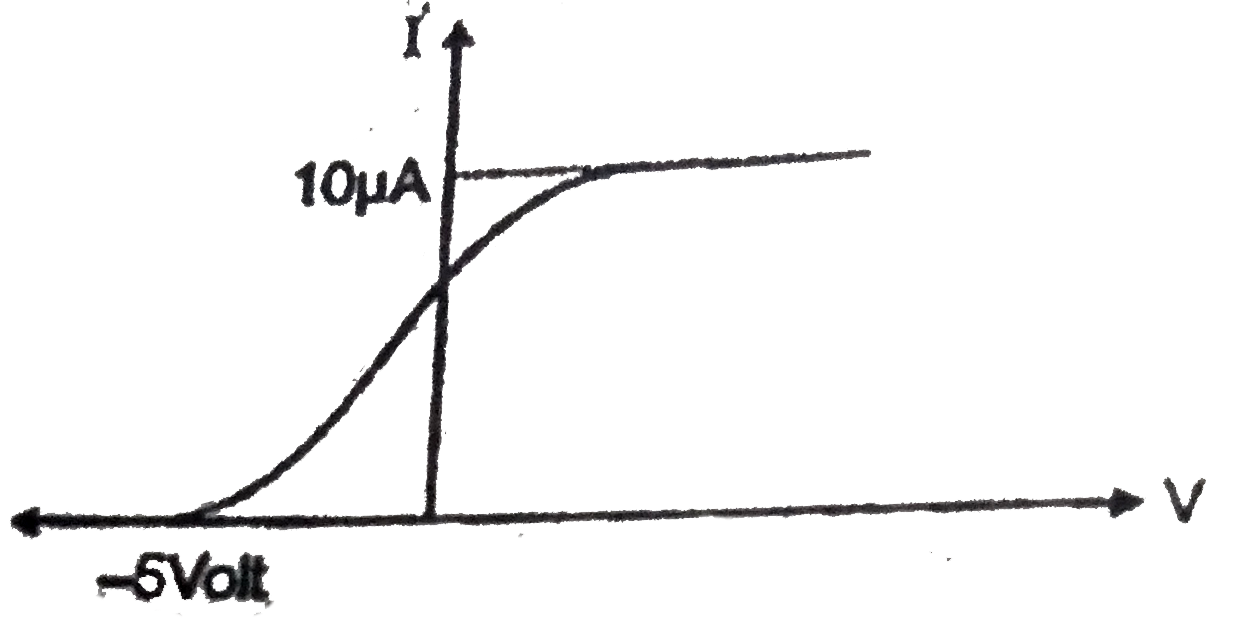 View Solution
View SolutionQuestion 44
In a photoelectric experiment light of different wavelengths are used on a metal surface. For each wavelength the stopping potential difference is recorded. The given graph shows the variation of stopping potential difference (Vs) versus the wavelength (l) of light used. Find the value of V0 shown in the graph. Given h=4×10–15eVs and c=3×108ms–1.
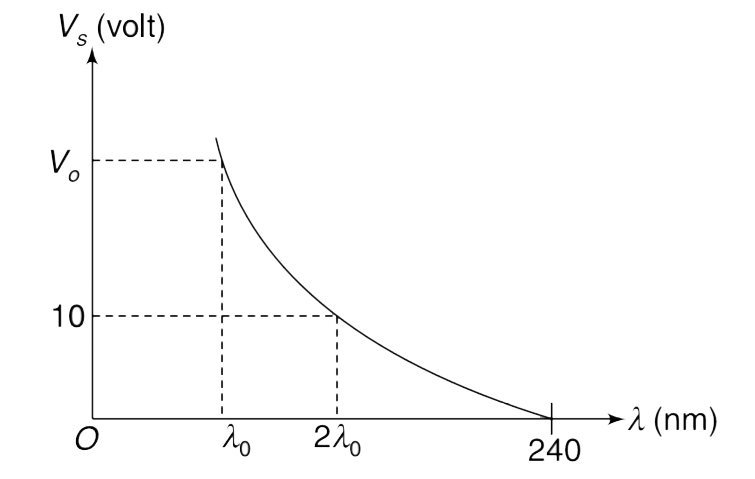 View Solution
View SolutionQuestion 45
In a photoelectric experiment, a monochromatic light is incident on the metal plate A. It was observed that with V=5volt, the maximum kinetic energy of photoelectrons striking plate B was 1eV. The polarity of the applied potential difference was as shown in figure (a). With polarity of the applied potential difference reversed (as shown in figure (b)) and frequency of incident light doubled, it was observed that in saturation state, the kinetic energy of electrons striking plate B ranged between 5 eV to 20 eV. Find the work function of metal used in plate A.
 View Solution
View SolutionQuestion 46
In a photoelectric experimental set-up ultraviolet light of wavelength 350 nm is incident on emitter plate (E). The work function of the emitter plate is ϕ=2.2 eV. AB is a uniform wire resistor having length L=100cm. Resistance of the wire AB is 10 W and the emf of the battery is V=10 volt. The sliding contact J can be moved along the wire AB. When the sliding contact is placed at end B of the wire resistor the micro-ammeter shows a reading of i=6μA. For answering the following questions assume that photoelectric current is very small compared to the current through the cell.
(a) Find the reading of the ammeter when the slider is moved to end A of the wire.
(b) The slider is moved gradually away from A. Plot the variation of ammeter reading versus distance of the slider measured from A.
(c) Find the maximum speed with which an electron will hit the collector plate (C) if slider J is placed at a distance of 95cm from A
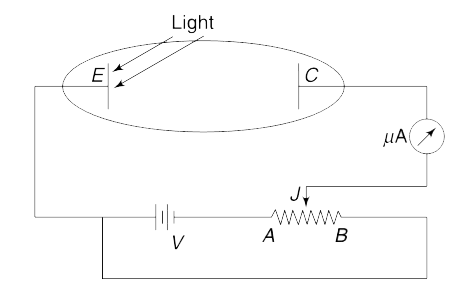 View Solution
View SolutionQuestion 47
A point source is emitting 0.2 W of ultravio- let radiation at a wavelength of λ=2537Å. This source is placed at a distance of 1.0m from the cathode of a photoelectric cell. The cathode is made of potassium (Work function =2.22eV) and has a surface area of 4cm2.
(a) According to classical theory, what time of exposure to the radiation shall be required for a potassium atom to accumulate sufficient energy to eject a photoelectron. Assume that radius of each potassium atom is 2 Å and it absorbs all energy incident on it.
(b) Photon flux is defined as number of light photons reaching the cathode in unit time. Calculate the photon flux.
(c) Photo efficiency is defined as probability of a photon being successful in knocking out an electron from the metal surface. Calculate the saturation photocurrent in the cell assuming a photo efficiency of 0.1.
(d) Find the cut – off potential difference for the cell. View SolutionQuestion 48
In photoelectric experiment set up, the maximum kinetic energy (kmax) of emitted photoelectrons was measured for different wavelength (λ) of light used. The graph of kmax vs 1λ was obtained as shown in first figure. In the same setup, keeping the wavelength of incident light fixed at l, the applied potential difference was varied and the photoelectric current was recorded. The result has been shown in graph in second figure.
(a) Find λ is Å
(b) Taking the photo efficiency to be 2% (i.e. percentage of incident photons which produce photoelectrons) find the power of light incident on the emitter plate in the experiment. [Take hc=12400eVÅ]
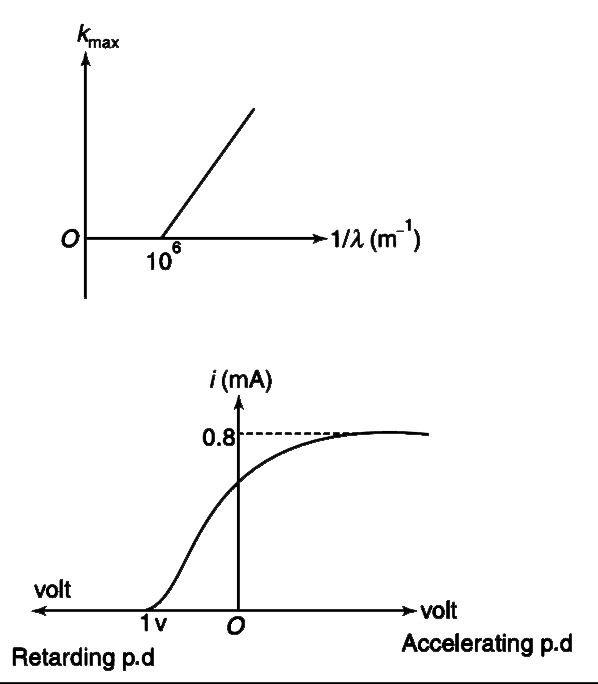 View Solution
View SolutionQuestion 49
A square plate of side length L absorbs all radiation incident on it. A point source of light is placed at a point P which is directly above a corner of the plate at a height L. The incident light on the plate produces a force of magnitude F0 on the plate. Calculate the magnitude of force on the plate if the source is moved to a point Q (Q is midpoint of the line PR).
 View Solution
View SolutionQuestion 50
A light photon of wavelength λ0 is absorbed by an atom of mass m at rest in ground state. The atom is free to move. The atom after absorbing the incident photon, emits another photon in direction opposite to that of the incident photon and returns back to its ground state. In the process the atom acquires a kinetic energy k. Find λ0 in terms of k and m. View SolutionQuestion 52
A point source (S) of light having power 500 W is kept at the focus of a lens of aperture diameter d. The focal length of the lens is 2d3 . Assume that 40% of the incident light energy is transmitted through the lens and the complete transmitted light is incident normally on a perfectly reflecting surface placed behind the lens. Calculate the force on the reflecting surface.
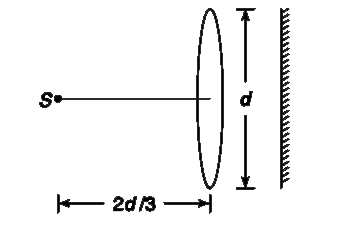 View Solution
View SolutionQuestion 53
An equilateral glass prism kept on a table has refractive index of μ=√2 . It is illuminated by a narrow laser beam having power P0 and wavelength l. The path of the laser beam inside the prism is parallel to the base of the prism. Calculate change in weight of the prism due to the incident laser beam.
 View Solution
View SolutionQuestion 54
A proton X is projected in a region of uniform electric field E with speed u. Another proton Y is projected simultaneously with same speed u in a separate region having a uniform magnetic field ‘B’. It was found that both X and Y had same de-Broglie wavelength after time T. Specific charge on a proton is σ(C/kg).
(a) Find the angle a at which the proton X was projected with respect to the direction of electric field.
(b) Find the displacement of the proton X in time T. View SolutionQuestion 55
It is possible for a photon to materialize into an electron and a position. The process is called pair production.
(a) Using conservation of energy and momentum prove that pair production cannot occur in empty space.
(b) Argue qualitatively that such pair production is possible near a nucleus. View SolutionQuestion 56
The figure shows the reflection of a plane wave by two neighbouring atoms on the surface of a crystal. The depicted waves are actually de-Broglie wave of electrons accelerated from rest by a potential difference of V volt. Neglect relativistic effects and take mass and charge of an electron to be m and e respectively. Calculate ϕ for the case of a constructive interference.
 View Solution
View SolutionQuestion 57
A particle of mass m is trapped between two perfectly rigid parallel walls. The particle bounces back and forth between the walls without losing any energy. From a wave point of view, the particle trapped between the walls is like a standing wave in a stretched string between the walls. Distance between the two walls is L.
(a) Calculate the energy difference between third energy state and the ground state (lowest energy state) of the particle.
(b) Calculate the ground state energy if the mass of the particle is m=1mg and separation between the walls is L=1cm. View SolutionQuestion 58
A moving H-atom makes a head on perfectly inelastic collision with a stationary Li++ ion. Just before collision, both −H and Li++ are in their first excited state. Immediately after collision H was found to be in ground state and Li++ was in its second excited state. Find the kinetic energy of H – atom before collision. No photon is emitted in the process. Assume that mass of Li++ is nearly 7 times the mass of H. View SolutionQuestion 60
Assume that structure of hydrogen atom is gov- erned by classical mechanics. An electron is circulating around a proton and it is radiating energy at a rate given dEdt=e2a26πc3∈0 where a is the acceleration of the electron.
Assume that speed of the electron is v(>>c).
(a) Estimate the fraction of kinetic energy lost by the electron per revolution in terms of v. Make suitable assumptions.
(b) Is the energy loss per revolution large? Is it safe to assume that orbit is circular during a small time interval? View SolutionQuestion 61
When radiations of wavelength λ1,λ2(=0.6λ1),λ3(=4λ2) and λ4 are incident on a metal plate, photoelectrons with maximum kinetic energy of – 5.2 eV are emitted for lambda_(1), 12 eV are emitted for λ2,0.95eV are emitted for λ4 and no electron is emitted for l3. It is known that a hydrogen like atom (atomic number Z) in a higher excited state of quantum number n can make a transition to first excited state by successively emitting two photons of wavelength λ1 and λ2 respectively. Alternatively, the atom from same excited state can make a transition to the second excited state by successively emitting two photons of wavelength λ3 and λ4 respectively.
(a) Find the work function of the metal.
(b) Find the values of n and Z for the atom. View SolutionQuestion 62
An electron approaches a fixed proton from a large distance with a kinetic energy of 12.2 eV. The electron gets captured by the proton to form a hydrogen atom in an excited state and a photon of wavelength λ1=796Å is emitted. Later, the hydrogen atom de-excites by emitting a single photon of wavelength λ2. Find λ2. [Take h=6.62×10–34Js,c=3×108m/s]View SolutionQuestion 63
A free hydrogen atom in its ground state is at rest. A neutron having kinetic energy k0 collides head one with the atom. Assume that mass of both neutron and the atom is same.
(a) Find minimum value of k0 so that this collision can be inelastic.
(b) If k0=25eV, find the kinetic energy of neutron after collision if its excites the hydrogen atom to its second excited state.
Take ionization energy of hydrogen atom in ground state to be 13.6eV.View SolutionQuestion 64
The X-ray spectrum of a metallic target has been shown in figure
(a) What is the accelerating potential difference for bombarding electrons?
(b) Two characteristic X-rays have been shown in the figure one of them is kα X-ray and the other one is kβ X-ray. What is wavelength of kα X-ray?
(c) Find the atomic number of the target atom.
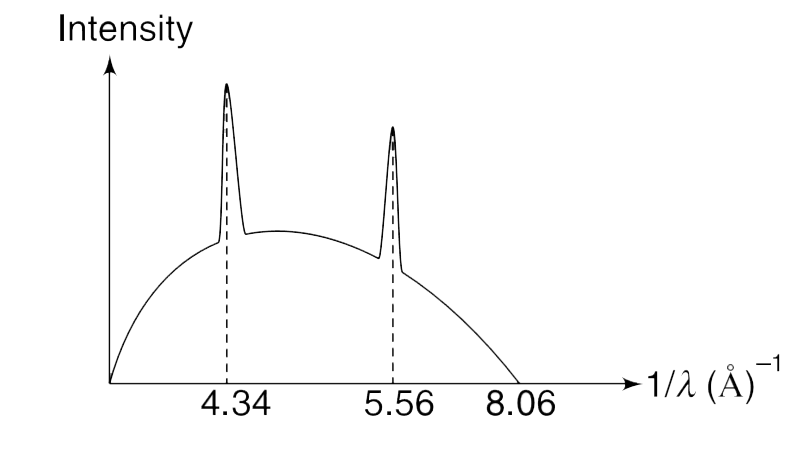 View Solution
View Solution

